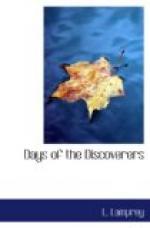He found, as he had expected, that the arctic waters were choked with ice, and turning southward he headed for the Faroe Isles. While in Holland he had had a letter from Captain John Smith, who had explored the regions about Chesapeake Bay. No straits leading to the western ocean had been discovered there, and no Sea of Verrazzano. Captain Smith’s opinion was that if such a passage existed it would be somewhere about the fortieth parallel. Explorations had already been made farther north. Davis Strait had been discovered some years before by John Davis, now dead. Martin Frobisher had found another strait leading northwest. Both of these were so far north that they were likely to be ice-bound by the time the little Half Moon could reach them. Hudson meant to look along the coast further south, and see what could be found there.
The Half Moon took in water at the Faroes and anchored some seven weeks later, on July 18, in Penobscot Bay. Her foremast was gone and her sails ripped and rent by the gales of the North Atlantic, and the carpenter with a selected crew rowed ashore and chose a pine tree for a new mast. While this was a-making and the sails were patched up, the crew not otherwise engaged went fishing.
“I say,” presently observed John Hudson, who knew Brereton’s Relacion by heart, “this must ha’ been the place where they caught so many fish that they were ‘pestered with Cod’ and threw numbers of ’em overboard. This makes twenty-seven, Dad, so far.”
During that week they caught fifty cod, a hundred lobsters and a halibut which John declared to be half as big as the ship. Two French boats appeared, full of Indians ready to trade beaver skins for red cloth. The strawberry season was past, but John found wild cherries, small, deep red, in heavy bunches. When he tried to eat them, however, they were so sour that he nearly choked. Cautiously he tasted the big blue whortleberries that grew on high bushes; near water, and found them delicious. He had been eating them by the handful for some time when he became aware that there was a feaster on the other side of the thicket. Receiving no reply to his challenge he went to investigate and saw a brown bear standing on his hind legs and raking the berries off the twigs with both forepaws, into his mouth. At sight of John he dropped on all fours and cantered off.
Leaving the bay they cruised along the coast past Cape Cod, and then steered southwest for the fortieth parallel. Wind and rain came on in the middle of August, and they were blown toward an inlet which Hudson decided to be the James. Not knowing how the English governor of Jamestown might regard an intrusion by a Dutch ship, he turned north again, and on the twenty-eighth of August entered a large bay and took soundings. More than once the Half Moon, light as she rode, grounded on sand-banks, and Hudson shook his head in rueful doubt.
“D’ you think the straits are here, Dad?” asked John when he had a chance to speak with his father alone.




